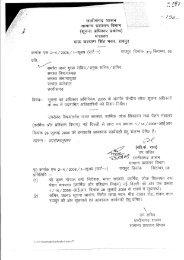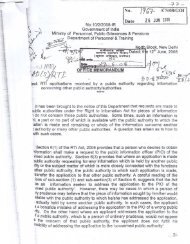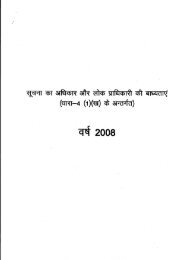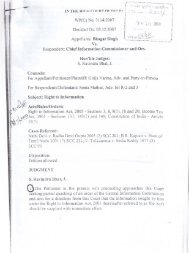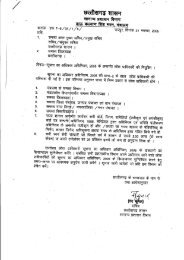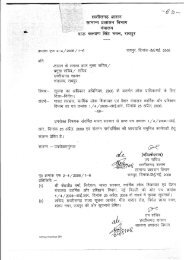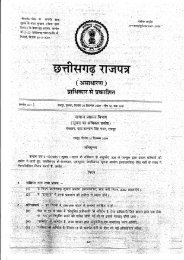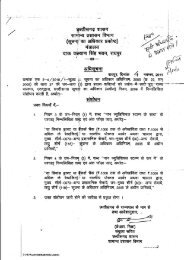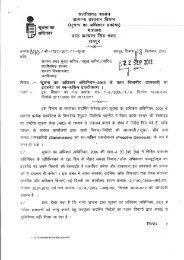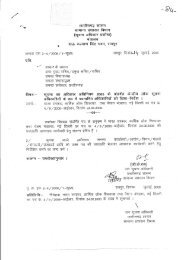sn" - CG State Information Commission
sn" - CG State Information Commission
sn" - CG State Information Commission
You also want an ePaper? Increase the reach of your titles
YUMPU automatically turns print PDFs into web optimized ePapers that Google loves.
-.13.t,...r j(xv) the particulars of facilities available to citizens for olrtaining information,including the working hours of a library or reading room, if maintdined f6r public use;(xvi) the names, designations and other particulars oflne Pubtic tnformation Officers.5. Besides the categories_ of information enumerated above, the Governrnent mayprescribe other categories of information to be published by any public eruthority. lt need bestressed that publication of the information as referred to abbve is'not opfional. d is a statutoryrequirement which every public authority is bound to meet.6. Another important point to note is that it is not sufficient to publish the above informationonce. The public authority is obliged to update such information every year. lt is advisable that,as far as possible, the information should be updated as and when any development takespla9e.-Particularly, in case of publication on the internet, the information should be keptupdated allthe time.7 - The public authority should widely disseminate the information. Dissemination shouldbe done in such form and manner which is easily accessible to the public. lt may be donethrough notice boards, newspapers, pubtic announcements, rnedia broarlcasl, the irrternet orany other means. The public authority should take into consideration the cost effectiveness,.local language and most effective method of communication in fire local area whiledissem inating the inforqration8. Public authorities formulate policies and take various decisions from time to time. Asprovided in the Act, while formulating important policies or announcing the decisions affectingthe public, the public authority should publish all relevant facts about such policies anldecisions for the information of public at large.Providins Reasons for DecisionsI'The public authorities take various administrative and quasi-judicial decisions whichaffect the interests of certain persons. lt is rnandatory for the concemed public authority toprovide reasons for such decisions to the affected persons. lt may be done Uy uiingappropriate mode of communication.10' Every pubiic authority is reuuired to designaie Public lnformation Officers in"all theadministrative units or offices undei it. Every puntic euthorlty is etsa :-equired te desianaleAssistant Public lnformation Officers at each sub-.divisional levei. the co'veinment of lnOii naidecided that Centrat Assislant Public lnformation Officers (CAplOs)"ppoint"O;; th"Depai-u-neiri of-PosFwouidaei-as-eAPirgsioralithe-pu'oiic-aritnoritir. uncier tn" aouonft"i ;;lndia.DesioinatioJ o_f Apoellate Authoritv11- Sub'-section (S) oJ Section 7 of the RTI Act provides that where a request for informationis rejected, the Public lnformation Officer shall, inter-atia, communicale the particulars of theAppellate Aulhority to the person making the request. Thus, the applicant is informed about theparticulars of the {pp.qttet: Authortty wt_e-n a request for information'is rejected but there may becases where'the Public lnforrnation Officer does not reject the applicition, but'the appliiantdoes not receive a decision within the time as specified in ttre Act'or he is aggrieved by thedecision of the Public lnformation Officer. ln such a case the applicant may tikiio exercise his



